Woodyard D. (ed.) Pounders Marine diesel engines and Gas Turbines
Подождите немного. Документ загружается.

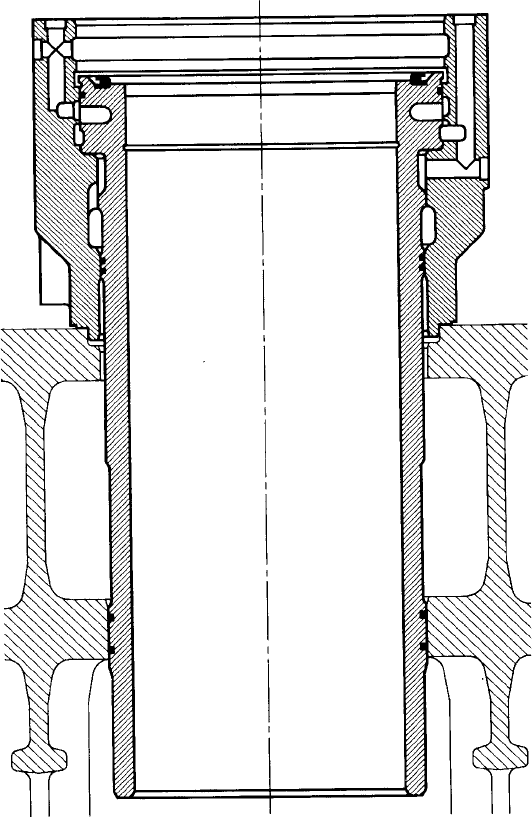
underwrites low fuel consumption. A rocking lever between pump plunger and
cam—horizontally adjustable by eccentric shaft—allows simple optimization
of injection timing. The injection nozzles can be preheated for operation on
heavy fuel oil (HFO).
High-efficiency and high air flow rates at full and part loads are delivered
by a constant pressure turbocharging system based on uncooled MAN turbo-
chargers. There is no need to preheat the air for part-load operation.
L58/64 engine 577
Figure 22.7 Cylinder liner of original L58/64 engine. a ame ring was specied in
later models (see Figure 22.21)

578 Man Diesel
upgraded L58/64 engine
The ageing (although still popular) L58/64 design benefited from an upgrading
in 2006, which targeted fuel savings across the operating range and reduced
emissions while maintaining the existing power ratings. Measures to enhance
reliability and accessibility for servicing were also introduced as well as
others seeking to extend maintenance intervals and shorten overhaul times.
As an example, the original camshaft housing, which comprised sheeting and
countless screws, was replaced by easily removed aluminium covers.
Approximately 70 per cent of the various assembly groups forming the
engine were either partly or completely redesigned, the modernization address-
ing all the components located above the crankcase. Many of the changes had
already been implemented on either or both of the smaller bore 32/40 and
48/60B engines. The 48/60B engine was particularly inspirational, some of its
concepts applied, tested and adapted to satisfy the structural conditions of the
larger bore model. Four key contributions to the upgrading were:
l Application of MAN Diesel’s latest generation TCA turbocharger.
l A new concept for controlling valve actuation.
l A complete cylinder head redesign.
l Extensive redesign of the exhaust system.
Figure 22.8 L58/64 engine cylinder head; note the exhaust valve with rotator

L58/64 engine 579
Figure 22.9 Cylinder jacket, head and cover of L58/64 engine
Figure 22.10 Cylinder head of L48/60 engine
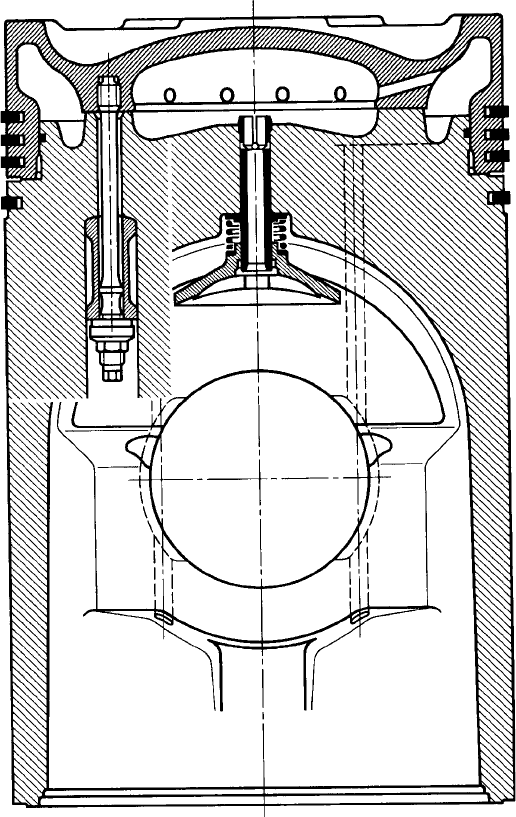
580 Man Diesel
A final assessment led to changes in the following main areas and assembly
groups: turbocharger attachment, new cylinder head and combustion chamber
design, new valve control, exhaust gas pipe and its environment and media supply.
TCA turbocharger series development by MAN achieved a high specific
flow rate, high efficiency, low noise emission, maintainability, uncomplicated
mounting to the engine, and high economic efficiency and reliability. Taking
advantage of these advances, TCA55 and TCA66 models displaced the MAN
NA48 and NA57 turbochargers previously fitted to the L58/64 engine. Now
positioned at the engine’s side, the TCA models are also smaller and lighter
than the predecessors. Additionally, a new turbocharger bracket was developed,
Figure 22.11 L58/64 engine composite piston

weighing considerably less and requiring less room than the earlier fitting. The
resulting free space was used for laying the supply pipes in a compact arrange-
ment. A reduced number of parts involved contribute to lower overall manufac-
turing costs for the engine.
In developing the new rocker arm concept for the MAN L58/64 engine
(Figure 22.17), the designers fulfilled a brief to create a simple and robust
arrangement fostering easy fitting, valve adjustment and removal. A combina-
tion of this valve actuator and new casting technology enabled the integration
of the charge air pipe into the rocker arm casing, dispensing with the support
system for the old charge air pipe.
L58/64 engine 581
Figure 22.12 The L58/64 engine connecting rod has a joint in the upper shaft

582 Man Diesel
Although most of the basic concept for the L58/64 engine’s revised cylinder
head derived from that of the 48/60B engine, it became apparent during the design
process that adaptation to the structural conditions of the larger bore model dic-
tated the modelling of a new head. By connecting the charge air pipe to the rocker
arm casing—thus simplifying the routing of the air flow—it became possible to
design a flatter and more compact cylinder head. This was also facilitated by the
operational reliability and wear resistance of the valves; renovating the valves and
seats had not been necessary outside regular maintenance intervals.
Both the exhaust pipe and the area around it were redesigned, leading to a
reassessment and tailoring of the insulation and covering, exhaust pipe supports,
exhaust gas blow-off device and charge air bypass to meet the demands set by
resizing. A flow velocity increase called for a redesign of the gas passage between
cylinder head and exhaust pipe, leading to a 50 per cent reduction in the pipe’s
cross-section. This enhanced exhaust admission to the turbocharger in non-
stationary engine operation, resulting in an improved turbocharger response time.
As a large number of new components were integrated into the existing engine
concept, MAN engineers took the opportunity to redesign the supply pipes, com-
bining the passage of media to the engine at optimized connection points.
Figure 22.13 a low piston dismantling height is achieved by the joint in the upper
part of the connecting rod shaft (L58/64, L48/60 and L40/54 engines)
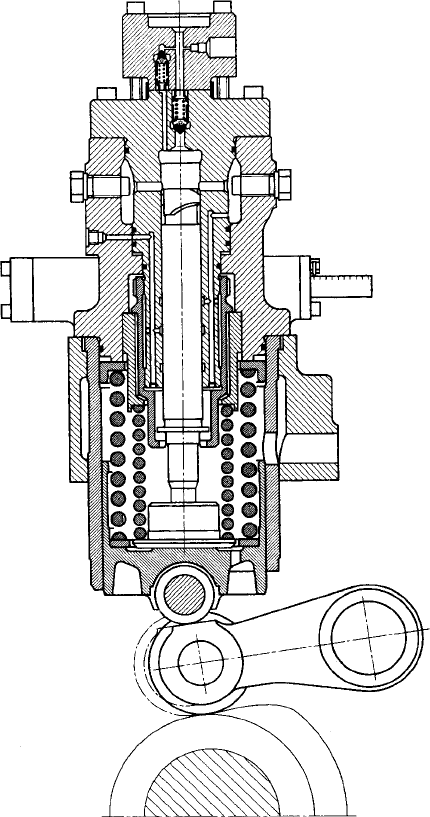
L40/54 and L/V48/60 engines
The L58/64 engine was followed on the market in 1987 by the L40/54 deriva-
tive, MAN Diesel’s experience with 400 mm bore designs at the time extend-
ing back over 20 years. The 40/45 design was introduced in the 1970s as an
updated shorter stroke version of the RV40/54 series which made its debut
in the mid-1960s as a ‘first generation’ modern medium-speed engine. These
older long stroke (540 mm) models were still produced by some licensees after
phase-out from the official programme.
L58/64 engine 583
Figure 22.14 L58/64 engine fuel injection pump
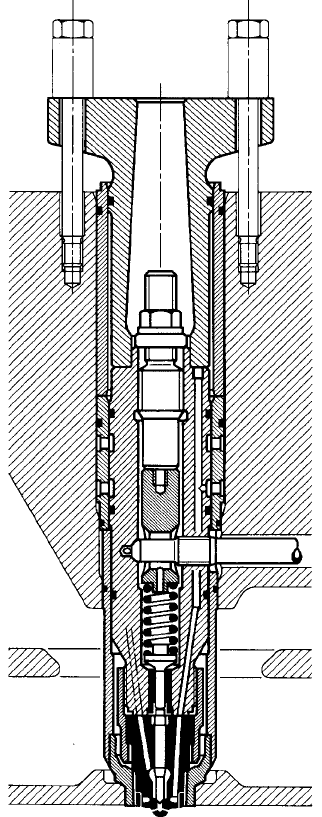
584 Man Diesel
A third member of the family, the L48/60 series, became available in in-line
cylinder form from end-1989. The prototype V-cylinder version, jointly devel-
oped with MAN Diesel’s associate company SEMT Pielstick of France, was
started up at end of 1990 and production engines were offered from early 1992.
The L/V48/60 series has since matured to B and CR versions, described later.
32/40 engine
The ‘new generation’ family was extended in September 1992 by a smaller
member to contest the competitive 320 mm bore propulsion and auxiliary power
arenas. The 32/40 series took the MAN medium-speed engine programme down
Figure 22.15 L58/64 engine fuel injection valve
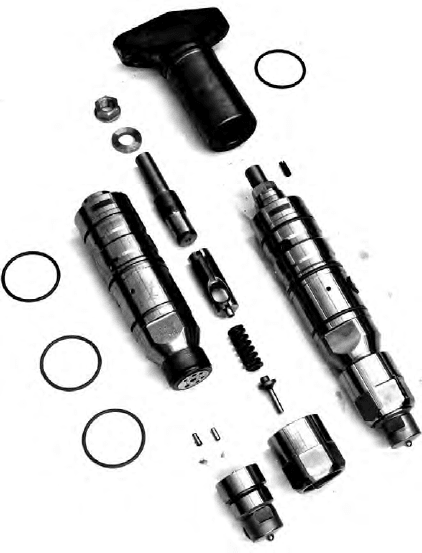
to cover an output band from 2200 kW to 7920 kW with five, six, seven, eight
and nine in-line and V12, 14, 16 and 18-cylinder models. The five-cylinder
model was later removed.
The 320 mm bore/400 mm stroke design (Figure 22.18) originally yielded
an output of 440 kW/cylinder at 720/750 rev/min on mean effective pressures
and mean piston speeds at these revolutions per minute ratings of 22.8/21.9 bar
and 9.6/10 m/s, respectively. A specific fuel consumption of just under 180 g/
kW h was quoted at 85 per cent maximum continuous rating. The 32/40 engine
is currently released with a rating of 500 kW/cylinder, the series now span-
ning a power band from 3000 kW to 9000 kW. The mean effective pressure is
24.9 bar (750 rev/min) and 25.9 bar (720 rev/min).
Proven elements of the larger bore brothers were down-scaled for the 32/40
engine: a stiff one-piece frame with tie-rods; cylinder liners in the jackets;
load-dependent cylinder lubrication; water-cooled liner fire rings with stepped
pistons; and variable injection timing for optimum adaptation of the engine
to various fuel grades (for both improved fuel consumption and reduced NOx
emissions). Fuel economy was targeted by a high stroke/bore ratio, constant
pressure turbocharging, a fuel-optimized injection system with ‘economy
plunger’, pressure-equalizing valves, high intensity atomization and high com-
pression ratio.
32/40 engine 585
Figure 22.16 Main components of L58/64 engine fuel injection valve
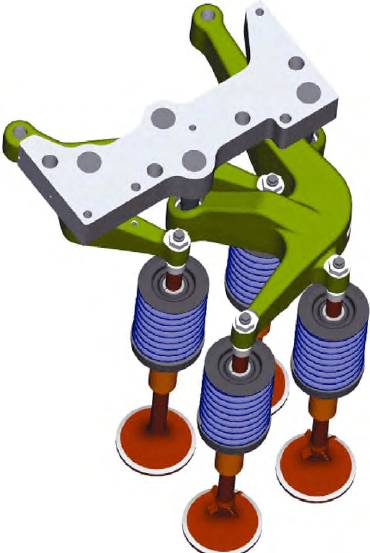
586 Man Diesel
An innovatory contribution to operating flexibility was made by the adop-
tion of separate camshafts (arranged on either side of the engine) for the fuel
injection and valve actuating gear. One camshaft is dedicated to drive the fuel
injection pumps and to operate the starting air pilot valves; the other camshaft,
on the opposite exhaust side, serves the inlet and exhaust valves. This arrange-
ment allows fuel injection and air charge renewal to be controlled independ-
ently, and thus engine operation to be optimized conveniently for either high
economy or low exhaust emissions.
In the larger bore MAN medium-speed engines, fuel injection timing may
be influenced by a laterally displaceable rocking lever arranged between cam-
shaft and pump tappet. The timing of the 32/40 engine, however, is adjusted by
turning the camshaft relative to the camshaft driving gear. Such a solution can
be applied without restriction because the air charge renewal cams are mounted
on a separate camshaft. The relative movement between driving gear and cam-
shaft is via a helically toothed sleeve integrated in the gearwheel, meshing with
the corresponding counterpart on the camshaft. By shifting the gear coaxially, the
camshaft (which is fixed in the coaxial direction) can be turned infinitely rela-
tive to the gear by the required and/or desired angle (Figure 22.19).
Figure 22.17 new rocker arm arrangement for the upgraded L58/64 engine, the
arms no longer sitting on a shaft but on two ball ends
